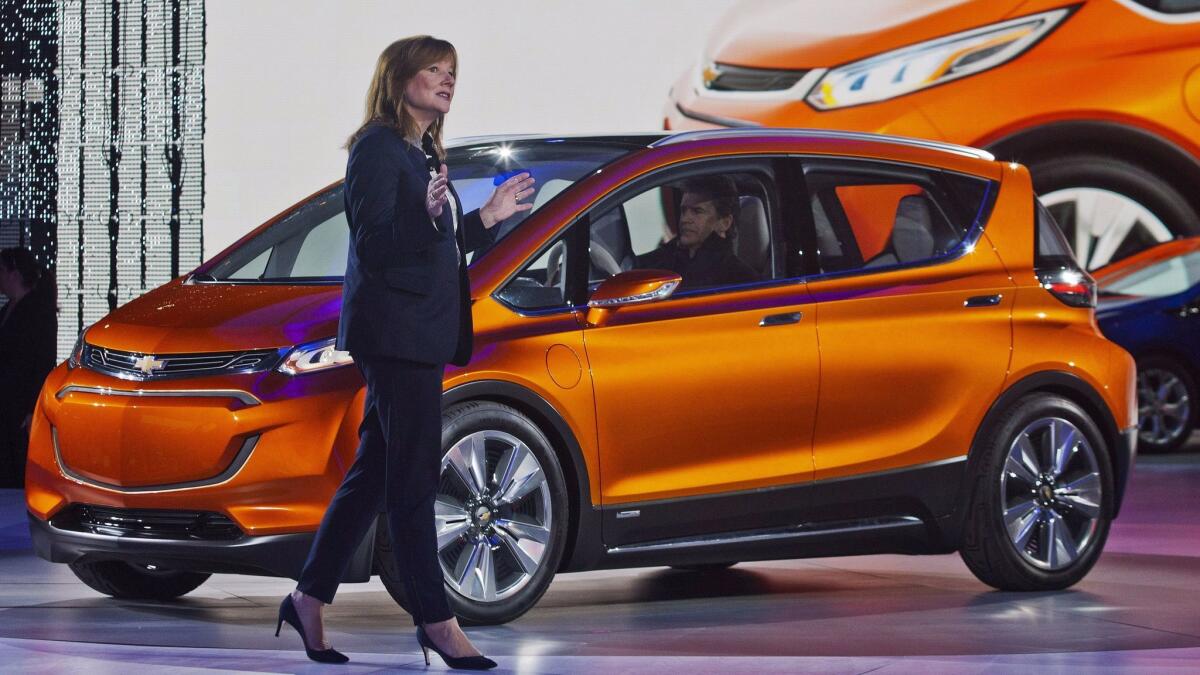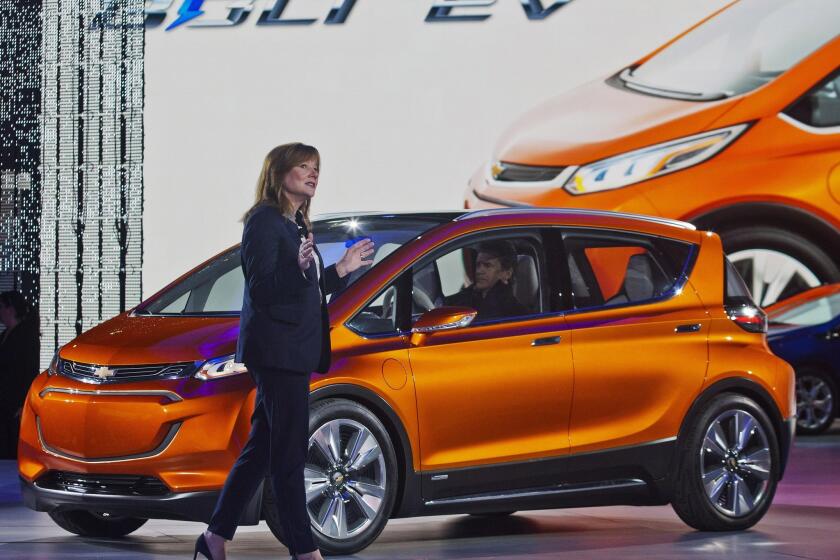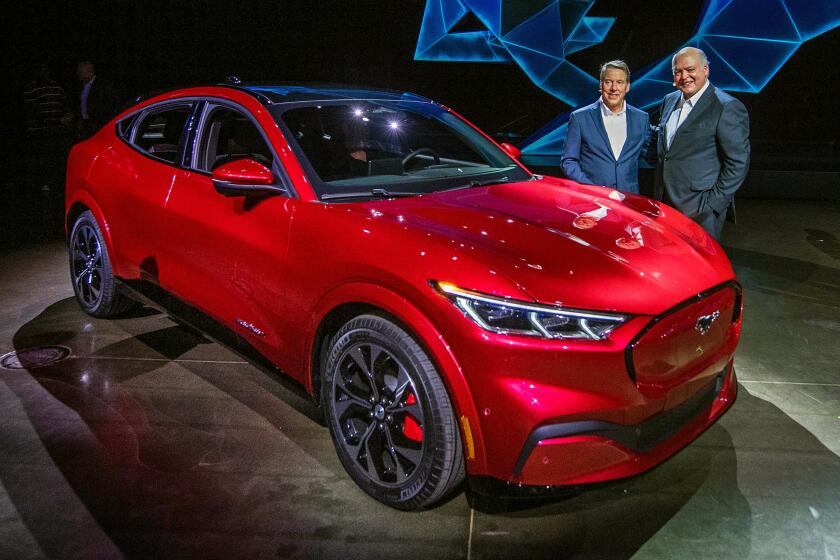GM plunges deeper into the EV market with a $20-billion spending plan

- Share via
General Motors laid out an aggressive electric vehicle strategy Wednesday, an approach it hopes will dramatically boost sales in California.
Chief Executive Mary Barra said GM would spend $20 billion on its electric and automated vehicle programs over the next five years, at which point it intends to be selling a million EVs a year in the U.S. and China. Key to the strategy is a joint venture with South Korea’s LG Chem that aims to boost driving range to 400 miles or more while reducing costs.
“We believe climate change is real,” Barra said. The company’s aggressive move into EVs, she said, “will dramatically change the future of this company and our industry.”
California, and the coastal states in the U.S. in general, has proved more amenable to EVs, giving GM the opportunity for faster growth beyond its base in mid-America. “We sell the most vehicles in the country right now,” she said. “We’re unrepresented on the coasts. It’s a huge opportunity for us.”
Or so GM hopes. In 2021, the company plans to introduce an all-electric GMC Hummer, an all-electric Silverado pickup, and an electric Cadillac SUV named the Lyriq.
Electric vehicles can cut greenhouse gases and carmakers have big plans for them. But so far, few car buyers want them.
It’ll take a few years to know whether GM’s aggressive move will be rewarded. Sales of the company’s Chevy Bolt EV compact car, introduced to great fanfare in 2017, have proved disappointing. In California, where about 50% of the nation’s EVs are sold, the Bolt attracted only about 8,000 buyers in 2019, compared with about 59,000 customers for the Tesla Model 3.
In the U.S., EV sales fell more than 6% in 2019, and they still represent only about 2% of the 17 million passenger vehicles sold.
GM is not the only automaker going out on an EV limb. Pushed by regulators worldwide, Volkswagen, Ford, Hyundai and others are risking billions on EV development.
Barra spoke to investors attending General Motors EV Day at the company’s technical and design center in Warren, Mich., just outside Detroit.
The company hopes to generate more investor excitement about GM’s future. Like other traditional automakers, GM has been stuck with a pallid stock price as Palo Alto-based Tesla’s shares soar. Tesla’s market value is three times that of GM, at about $137 billion, even though GM’s overall annual revenue is more than five times greater than Tesla’s. GM earns billions in annual profits whereas Tesla has not scored an annual profit since it went public in 2010.

GM’s share price jumped 3.3%, closing the day at $31.53.
GM’s EV and automated vehicle approach represents “the biggest opportunity anybody has ever seen for this company,” GM President Mark Reuss told investors.
Engineers introduced what GM calls its Ultium electric car platform, an EV-only modular design similar to what Tesla, Rivian and other EV makers already use. Known generically as a “skateboard” design, it provides the base of a modern electric car — the wheels, the motors, the battery pack, the suspension system. Without a gasoline or diesel engine to get in the way, the flexible skateboard design can accommodate different vehicle styles, ranging, Reuss said, “from full-size trucks to crossovers to cars and even self-driving vehicles.”
A skateboard can be resized and reconfigured to adjust to different models with relative ease. GM plans to use the modular design and better battery technology to lower costs and boost range over 400 miles. Range anxiety is considered one of the biggest impediments to consumer interest in electric cars. Few EVs today boast a range over 250 miles, though some Tesla models claim a maximum range of 370 miles.
Ford turns to electrified pickups, performance cars and SUVs to meet California’s greenhouse gas regulations.
GM plans to make its own battery cells and battery packs, as Tesla does. With partner LG Chem of South Korea, GM is building a giant factory in Lordstown, Ohio — the size of 30 football fields, the company says — to turn out 30 gigawatt-hours of battery power per year. That’s about the size of Tesla’s so-called Gigafactory outside Reno.
It’s not yet been shown that automakers can make money selling electric cars. But through modular car design, vertical battery integration, manufacturing scale and aggressive cost cutting, Reuss said, “we intend to do this profitably.”
The company said it wasn’t far from reaching the $100-per-kilowatt-hour cost level in battery manufacturing, the point at which analysts believe EVs can compete on price with internal combustion engines. Currently, an electric vehicle can cost $10,000 more than its similarly equipped internal combustion counterpart.
GM also talked about its Super Cruise driver-assist technology, which can navigate automatically through highway traffic. It’s similar to Tesla’s Autopilot but uses a different technology to monitor driver attention — a camera that can monitor whether the driver is watching the road. Autopilot senses a hand on the steering wheel.
Consumer Reports and safety experts in general say that the Super Cruise-style camera system does a better job of keeping a driver alert.
Super Cruise is currently only in the Cadillac CT6, but Reuss said the Bolt EV would be sold with the option soon and that 10 vehicles would offer the option next year and 22 vehicles by 2023.
More to Read
Inside the business of entertainment
The Wide Shot brings you news, analysis and insights on everything from streaming wars to production — and what it all means for the future.
You may occasionally receive promotional content from the Los Angeles Times.













